brake light TOYOTA HIGHLANDER HYBRID 2023 Owners Manual
[x] Cancel search | Manufacturer: TOYOTA, Model Year: 2023, Model line: HIGHLANDER HYBRID, Model: TOYOTA HIGHLANDER HYBRID 2023Pages: 572, PDF Size: 14.07 MB
Page 3 of 572

3TABLE OF CONTENTS
1
2
3
4
5
6
7
8
9
10
Hybrid transmission............213
Turn signal lever................. 216
Parking brake ..................... 217
Brake Hold ......................... 220
4-3. Operating the lights and wip- ers
Headlight switch ................. 223
Automatic High Beam ........ 226
Fog light switch .................. 229
Windshield wipers and washer ......................................... 229
Rear windshield wiper and washer ............................. 232
4-4. Refueling Opening the fuel tank cap .. 234
4-5. Using the driving support sys- tems
Toyota Safety Sense 2.5 +......................................... 237
PCS (Pre-Collision System) ......................................... 242
LTA (Lane Tracing Assist)... 253
Dynamic radar cruise control with full-speed range ........ 263
RSA (Road Sign Assist) ..... 275
BSM (Blind Spot Monitor)... 278
Intuitive parking assist ........ 283
RCTA (Rear Cross Traffic Alert) function ............................ 291
PKSB (Parking Support Brake) ......................................... 297
Parking Support Brake function (static objects) .................. 304
Parking Support Brake function (rear-crossing vehicles).... 307
Driving mode select switch ......................................... 308
Trail Mode .......................... 309
Driving assist systems........ 311
4-6. Driving tips Hybrid Electric Vehicle driving tips ................................... 318Winter driving tips ..............
320
Utility vehicle precautions .. 323
5-1. Using the air conditioning system and defogger
Front automatic air conditioning
system ............................. 328
Rear automatic air conditioning system ............................. 337
Heated steering wheel/seat heaters/seat ventilators.... 341
5-2. Using the interior lights Interior lights list ................. 343
5-3. Using the storage features List of storage features ...... 346
Luggage compartment features ......................................... 350
5-4. Using the other interior fea- tures
Other interior features ........ 355
Garage door opener........... 370
6-1. Maintenance and care Cleaning and protecting the vehicle exterior................. 380
Cleaning and protecting the vehicle interi or.................. 38
3
6-2. Maintenance Maintenance requirements......................................... 386
General maintenance......... 388
Emission inspection and mainte- nance (I/M) programs ...... 390
6-3. Do-it-yourself maintenance Do-it-yourself service precau-tions ................................. 392
Hood .................................. 394
5Interior features
6Maintenance and care
Page 19 of 572
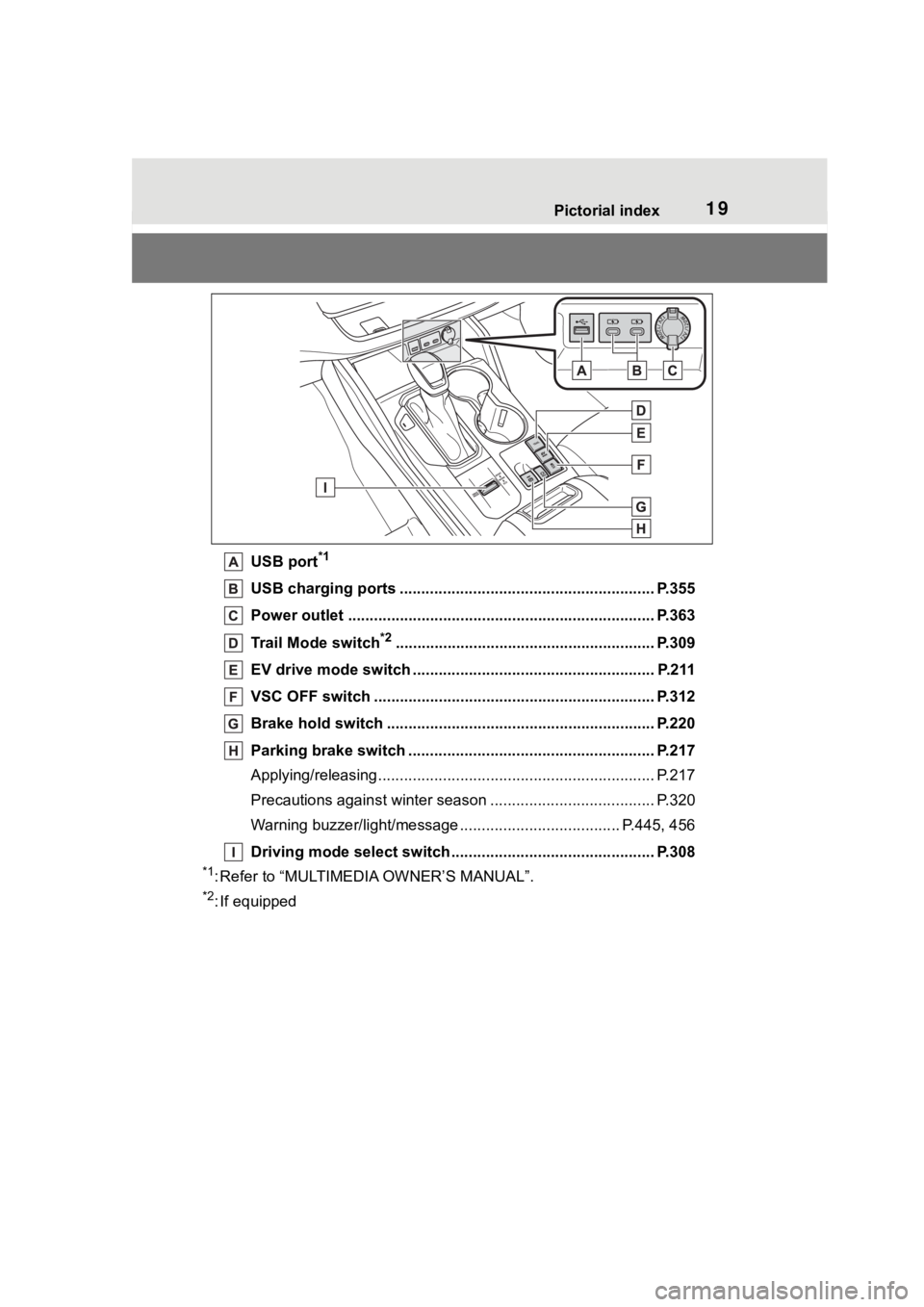
19Pictorial index
USB port*1
USB charging ports ........................................................... P.355
Power outlet ................................................... .................... P.363
Trail Mode switch
*2............................................................ P.3 09
EV drive mode switch ........................................... ............. P.211
VSC OFF switch ................................................. ................ P.312
Brake hold switch .............................................. ................ P.220
Parking brake switch ........................................... .............. P.217
Applying/releasing............................................. ................... P.217
Precautions against winter season .............................. ........ P.320
Warning buzzer/light/message ................................... .. P.445, 456
Driving mode select switch ..................................... .......... P.308
*1: Refer to “MULTIMEDIA OWNER’S MANUAL”.
*2: If equipped
Page 36 of 572

361-1. For safe use
Airbag sensor assembly
Your vehicle is equipped with ADVANCED AIRBAGS designed
based on the US motor vehicle safety standards (FMVSS208). The
airbag sensor assembly (ECU) cont rols airbag deployment based on
information obtained from the sensors etc. shown in the system
components diagram above. This in formation includes crash sever-
ity and occupant information. As the airbags deploy, a chemical
reaction in the inflators quickly fills the airbags with non-toxic gas to
help restrain the motion of the occupants.
■If the SRS airbags deploy
(inflate)
●Slight abrasions, burns, bruising
etc., may be sustained from SRS
airbags, due to the extremely high
speed deployment (inflation) by
hot gases.
●A loud noise and white powder will
be emitted.
●Parts of the airbag module (steer-
ing wheel hub, airbag cover and
inflator) as well as the front seats,
parts of the front and rear pillars,
and roof side rails, may be hot for
several minutes. T he airbag itself
may also be hot.
●The windshield may crack.
●The hybrid system will be stopped
and fuel supply to the engine will
be stopped. ( P. 7 6 )
●All of the doors will be unlocked.
( P.128)
●The brakes and st op lights will be
controlled automatically. ( P.312)
●The interior lights will turn on auto-
matically. ( P.345)
●The emergency flashers will turn
on automatically. ( P.438)
●For Safety Connect subscribers, if
any of the following situations
occur, the system is designed to
send an emergency call to the
response center, notifying them of
the vehicle’s location (without
needing to push the “SOS” button)
and an agent will attempt to speak with the occupants to ascertain
the level of emergency and assis-
tance required. If the occupants
are unable to communicate, the
agent automatically treats the call
as an emergency and helps to dis-
patch the necessary emergency
services. (
P. 6 5 )
• An SRS airbag is deployed.
• A seat belt pretensioner is acti- vated.
• The vehicle is involved in a severe rear-end collision.
■SRS airbag deployment condi-
tions (SRS front airbags)
●The SRS front airbags will deploy
in the event of an impact that
exceeds the set threshold level
(the level of forc e corresponding
to an approximately 12 - 18 mph
[20 - 30 km/h] frontal collision with
a fixed wall that does not move or
deform).
However, this threshold velocity will
be considerably higher in the follow-
ing situations:
• If the vehicle strikes an object, such as a parked vehicle or sign
pole, which can move or deform
on impact
• If the vehicle is involved in an underride collision, such as a colli-
sion in which the front of the vehi-
cle “underrides”, or goes under,
the bed of a truck
●Depending on the type of collision,
it is possible that only the seat belt
pretensioners and SRS seat cush-
Page 83 of 572
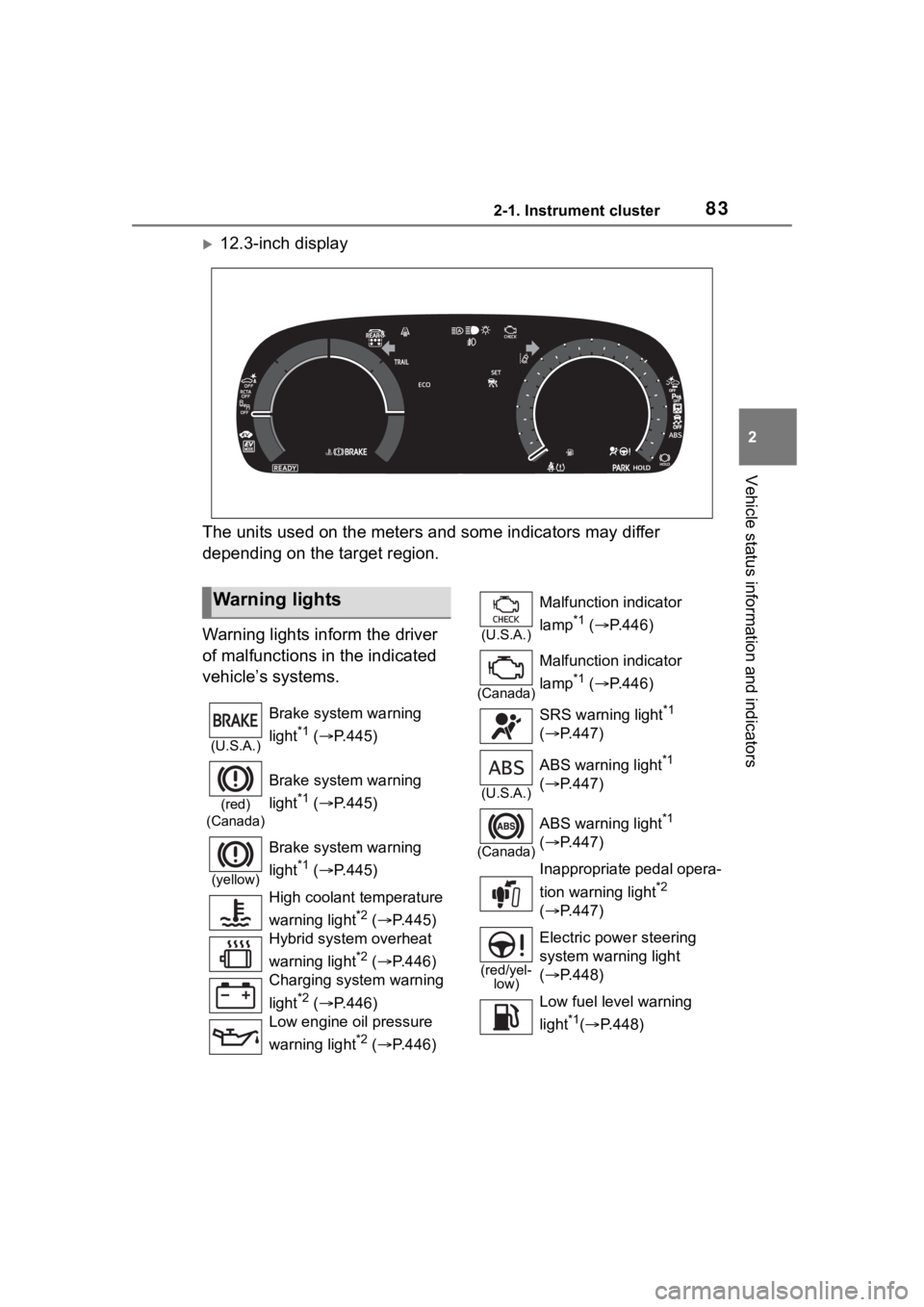
832-1. Instrument cluster
2
Vehicle status information and indicators
12.3-inch display
The units used on the meters and some indicators may differ
depending on the target region.
Warning lights inform the driver
of malfunctions in the indicated
vehicle’s systems.
Warning lights
(U.S.A.)
Brake system warning
light
*1 ( P.445)
(red)
(Canada)
Brake system warning
light
*1 ( P.445)
(yellow)
Brake system warning
light
*1 ( P.445)
High coolant temperature
warning light
*2 ( P.445)
Hybrid system overheat
warning light
*2 ( P.446)
Charging system warning
light
*2 ( P.446)
Low engine oil pressure
warning light
*2 ( P.446)
(U.S.A.)
Malfunction indicator
lamp
*1 ( P.446)
(Canada)
Malfunction indicator
lamp
*1 ( P.446)
SRS warning light
*1
( P.447)
(U.S.A.)
ABS warning light*1
( P.447)
(Canada)
ABS warning light*1
( P.447)
Inappropriate pedal opera-
tion warning light
*2
( P.447)
(red/yel-
low)
Electric power steering
system warning light
( P.448)
Low fuel leve l warning
light
*1( P.448)
Page 84 of 572
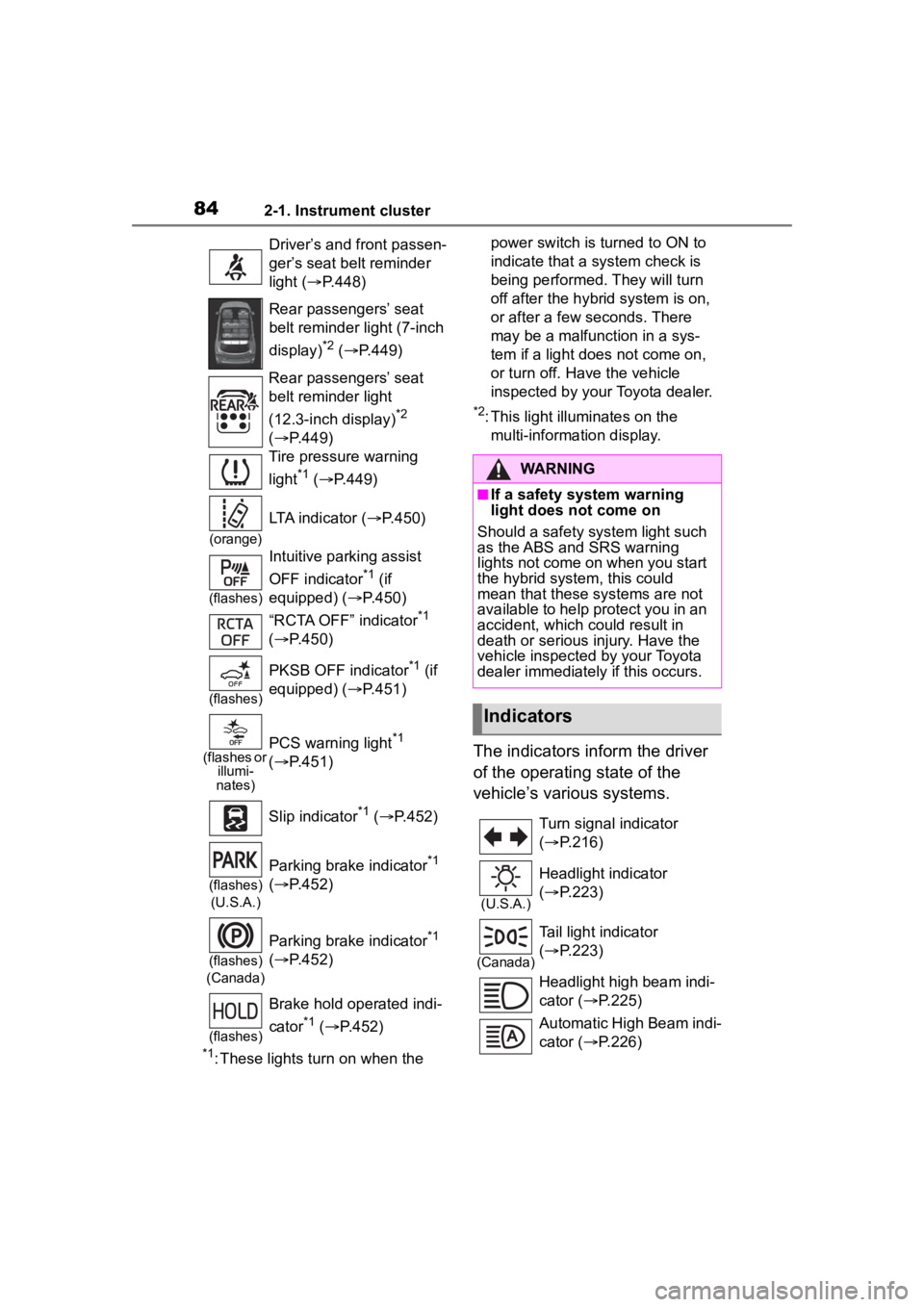
842-1. Instrument cluster
*1: These lights turn on when the power switch is turned to ON to
indicate that a system check is
being performed. They will turn
off after the hybr
id system is on,
or after a few seconds. There
may be a malfunction in a sys-
tem if a light does not come on,
or turn off. Have the vehicle
inspected by your Toyota dealer.
*2: This light illuminates on the multi-information display.
The indicators inform the driver
of the operating state of the
vehicle’s various systems.
Driver’s and front passen-
ger’s seat belt reminder
light ( P.448)
Rear passengers’ seat
belt reminder light (7-inch
display)
*2 ( P.449)
Rear passengers’ seat
belt reminder light
(12.3-inch display)
*2
( P.449)
Tire pressure warning
light
*1 ( P.449)
(orange)
LTA indicator ( P.450)
(flashes)
Intuitive parking assist
OFF indicator
*1 (if
equipped) ( P.450)
“RCTA OFF” indicator
*1
( P.450)
(flashes)
PKSB OFF indicator*1 (if
equipped) ( P.451)
(flashes or
illumi-
nates)PCS warning light*1
( P.451)
Slip indicator
*1 ( P.452)
(flashes)
(U.S.A.)
Parking brake indicator*1
( P.452)
(flashes)
(Canada)
Parking brake indicator*1
( P.452)
(flashes)
Brake hold operated indi-
cator
*1 ( P.452)
WARNING
■If a safety system warning
light does not come on
Should a safety system light such
as the ABS and SRS warning
lights not come on when you start
the hybrid system, this could
mean that these s ystems are not
available to help protect you in an
accident, which could result in
death or serious injury. Have the
vehicle inspected by your Toyota
dealer immediately if this occurs.
Indicators
Turn signal indicator
( P.216)
(U.S.A.)
Headlight indicator
( P.223)
(Canada)
Tail light indicator
( P.223)
Headlight high beam indi-
cator ( P.225)
Automatic High Beam indi-
cator ( P.226)
Page 85 of 572

852-1. Instrument cluster
2
Vehicle status information and indicators
Drive mode indicators
*1: This light comes on when the
system is turned off.
*2: These lights tu rn on when the
power switch is turned to ON to
indicate that a system check is
being performed. They will turn
off after the hybr id system is on,
or after a few seconds. There
may be a malfunction in a sys-
tem if a light does not come on,
or turn off. Have the vehicle
inspected by your Toyota dealer.
*3: This light illuminates on the out- side rear view mirrors.
Front fog light indicator
(
P.229)
PCS warning light
*1, 2
( P.242)
Cruise control indicator
( P.263)
Dynamic radar cruise con-
trol indicator ( P.263)
Cruise control “SET” indi-
cator ( P.263)
*7
LTA i n d i c a t o r ( P.242,
259)
BSM outside rear view
mirror indicators
*2, 3
( P.278, 291)
BSM OFF indicator
*1, 2
( P.278)
Intuitive parking assist
OFF indicator
*1, 2(if
equipped) (P.284)
“RCTA OFF” indicator
*1, 2
( P.292)
PKSB OFF indicator
*1, 2(if
equipped) (P.299)
(flashes)
Slip indicator*2 ( P.312)
VSC OFF indicator
*1, 2
( P.313)
Smart key system indica-
tor
*4 ( P.207)
“READY” indicator
( P.207)
EV drive mode indicator
( P.211)
(U.S.A.)
Parking brake indicator*2
( P.217)
(Canada)
Parking brake indicator*2
( P.217)
Brake hold standby indica-
tor
*2 ( P.220)
Brake hold operated indi-
cator
*2 ( P.220)
EV indicator ( P. 7 0 )
Low outside temperature
indicator
*6 ( P.87)
Security indicator
*5
( P.77, 78)
“PASS AIR BAG ON/OFF”
indicator
*2, 5 ( P. 4 3 )
“PASS AIR BAG
ON/OFF” indicator
*2,
5
( P. 4 3 )
Eco drive mode indicator
( P.308)
Sport mode indicator
( P.308)
Trail Mode ind icator (if
equipped) ( P.309)
Page 183 of 572

183
4
4
Driving
Driving
.4-1. Before drivingDriving the vehicle....... 184
Cargo and luggage ..... 191
Vehicle load limits ....... 194
Trailer towing............... 195
Dinghy towing ............. 206
4-2. Driving procedures Power (ignition) switch.................................. 207
EV drive mode ............ 211
Hybrid transmission .... 213
Turn signal lever.......... 216
Parking brake .............. 217
Brake Hold .................. 220
4-3. Operating the lights and wipers
Headlight switch .......... 223
Automatic High Beam . 226
Fog light switch ........... 229
Windshield wipers and washer....................... 229
Rear windshield wiper and washer....................... 232
4-4. Refueling Opening the fuel tank cap.................................. 234
4-5. Using the driving support
systems
Toyota Safety Sense 2.5 + .................................. 237PCS (Pre-Collision System)
.................................. 242
LTA (Lane Tracing Assist) .................................. 253
Dynamic radar cruise con- trol with full-speed range
.................................. 263
RSA (Road Sign Assist) .................................. 275
BSM (Blind Spot Monitor) .................................. 278
Intuitive parking assist . 283
RCTA (Rear Cross Traffic Alert) function ............ 291
PKSB (Parking Support Brake) ........................ 297
Parking Support Brake func- tion (static objects) .... 304
Parking Support Brake func- tion (rear-crossing vehi-
cles) ........................... 307
Driving mode select switch .................................. 308
Trail Mode ................... 309
Driving assist systems .................................. 311
4-6. Driving tips Hybrid Electric Vehicle driv-ing tips ....................... 318
Winter driving tips........ 320
Utility vehicle precautions .................................. 323
Page 186 of 572
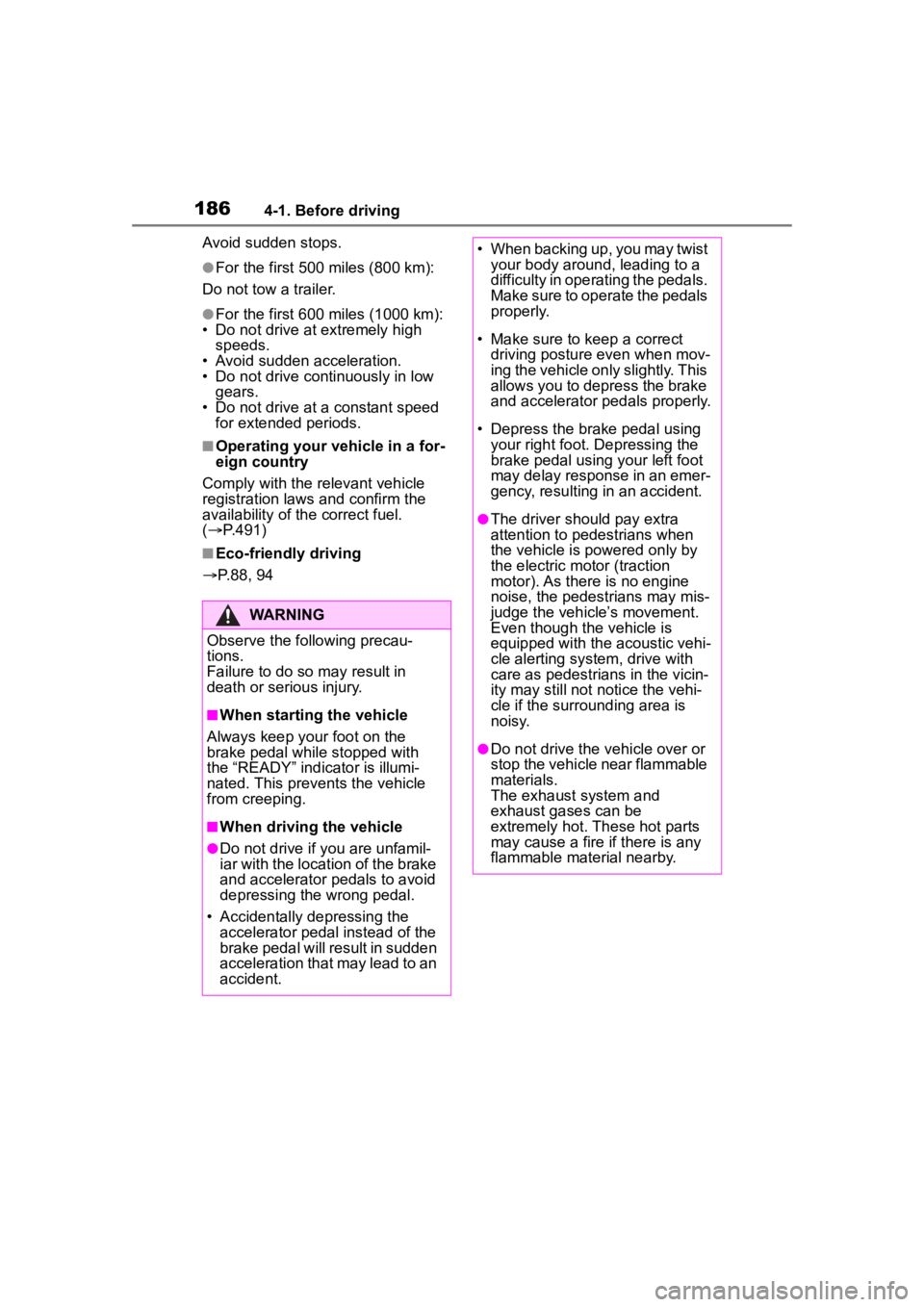
1864-1. Before driving
Avoid sudden stops.
●For the first 500 miles (800 km):
Do not tow a trailer.
●For the first 600 miles (1000 km):
• Do not drive at extremely high
speeds.
• Avoid sudden acceleration.
• Do not drive continuously in low gears.
• Do not drive at a constant speed for extended periods.
■Operating your vehicle in a for-
eign country
Comply with the relevant vehicle
registration laws and confirm the
availability of the correct fuel.
( P.491)
■Eco-friendly driving
P.88, 94
WARNING
Observe the following precau-
tions.
Failure to do so m ay result in
death or serious injury.
■When starting the vehicle
Always keep your foot on the
brake pedal while stopped with
the “READY” indicator is illumi-
nated. This prevents the vehicle
from creeping.
■When driving the vehicle
●Do not drive if y ou are unfamil-
iar with the location of the brake
and accelerator pedals to avoid
depressing the wrong pedal.
• Accidentally depressing the accelerator pedal instead of the
brake pedal will result in sudden
acceleration that may lead to an
accident.
• When backing up, you may twist your body around, leading to a
difficulty in operating the pedals.
Make sure to operate the pedals
properly.
• Make sure to keep a correct driving posture even when mov-
ing the vehicle only slightly. This
allows you to depress the brake
and accelerator pedals properly.
• Depress the brake pedal using your right foot. Depressing the
brake pedal using your left foot
may delay response in an emer-
gency, resulting in an accident.
●The driver should pay extra
attention to pedestrians when
the vehicle is powered only by
the electric motor (traction
motor). As there is no engine
noise, the pedestrians may mis-
judge the vehicle’s movement.
Even though the vehicle is
equipped with the acoustic vehi-
cle alerting system, drive with
care as pedestrians in the vicin-
ity may still not n otice the vehi-
cle if the surrounding area is
noisy.
●Do not drive the vehicle over or
stop the vehicle near flammable
materials.
The exhaust system and
exhaust gases can be
extremely hot. These hot parts
may cause a fire i f there is any
flammable material nearby.
Page 187 of 572
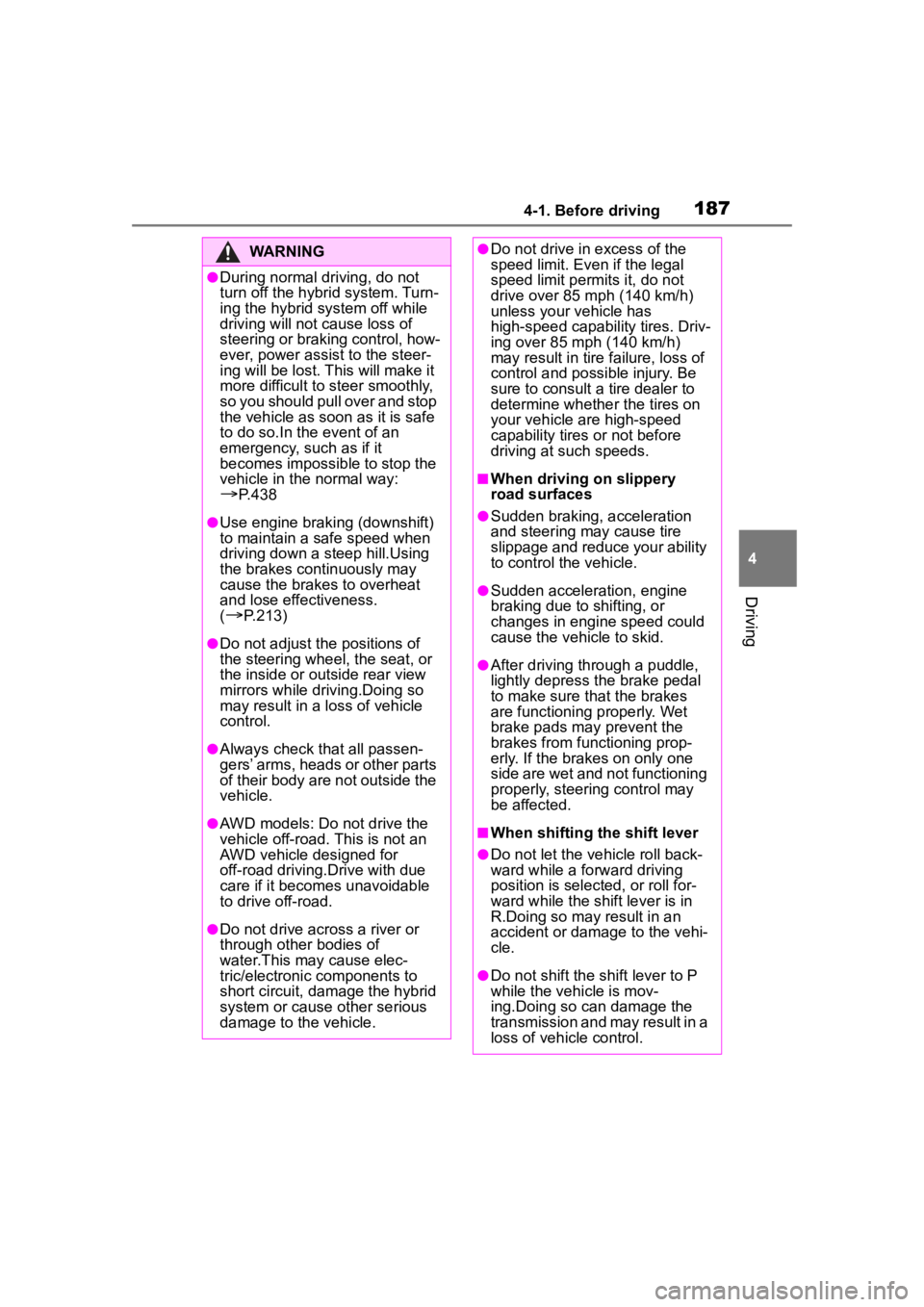
1874-1. Before driving
4
Driving
WARNING
●During normal driving, do not
turn off the hybrid system. Turn-
ing the hybrid system off while
driving will not cause loss of
steering or braking control, how-
ever, power assist to the steer-
ing will be lost. This will make it
more difficult to steer smoothly,
so you should pull over and stop
the vehicle as soon as it is safe
to do so.In the event of an
emergency, such as if it
becomes impossible to stop the
vehicle in the normal way:
P. 4 3 8
●Use engine braking (downshift)
to maintain a safe speed when
driving down a steep hill.Using
the brakes con tinuously may
cause the brakes to overheat
and lose effectiveness.
(
P.213)
●Do not adjust the positions of
the steering wheel, the seat, or
the inside or ou tside rear view
mirrors while driving.Doing so
may result in a loss of vehicle
control.
●Always check that all passen-
gers’ arms, heads or other parts
of their body are not outside the
vehicle.
●AWD models: Do not drive the
vehicle off-road. This is not an
AWD vehicle designed for
off-road driving.Drive with due
care if it becomes unavoidable
to drive off-road.
●Do not drive across a river or
through other bodies of
water.This may cause elec-
tric/electronic components to
short circuit, damage the hybrid
system or cause other serious
damage to the vehicle.
●Do not drive in excess of the
speed limit. Even if the legal
speed limit permits it, do not
drive over 85 mph (140 km/h)
unless your vehicle has
high-speed capability tires. Driv-
ing over 85 mph (140 km/h)
may result in tire failure, loss of
control and possible injury. Be
sure to consult a tire dealer to
determine whether the tires on
your vehicle are high-speed
capability tires or not before
driving at such speeds.
■When driving on slippery
road surfaces
●Sudden braking, acceleration
and steering may cause tire
slippage and reduce your ability
to control the vehicle.
●Sudden acceleration, engine
braking due to shifting, or
changes in engine speed could
cause the vehicle to skid.
●After driving through a puddle,
lightly depress the brake pedal
to make sure that the brakes
are functioning properly. Wet
brake pads may prevent the
brakes from functioning prop-
erly. If the brakes on only one
side are wet and not functioning
properly, steering control may
be affected.
■When shifting the shift lever
●Do not let the vehicle roll back-
ward while a fo rward driving
position is selected, or roll for-
ward while the shift lever is in
R.Doing so may result in an
accident or damage to the vehi-
cle.
●Do not shift the sh ift lever to P
while the vehicle is mov-
ing.Doing so can damage the
transmission and may result in a
loss of vehicle control.
Page 188 of 572
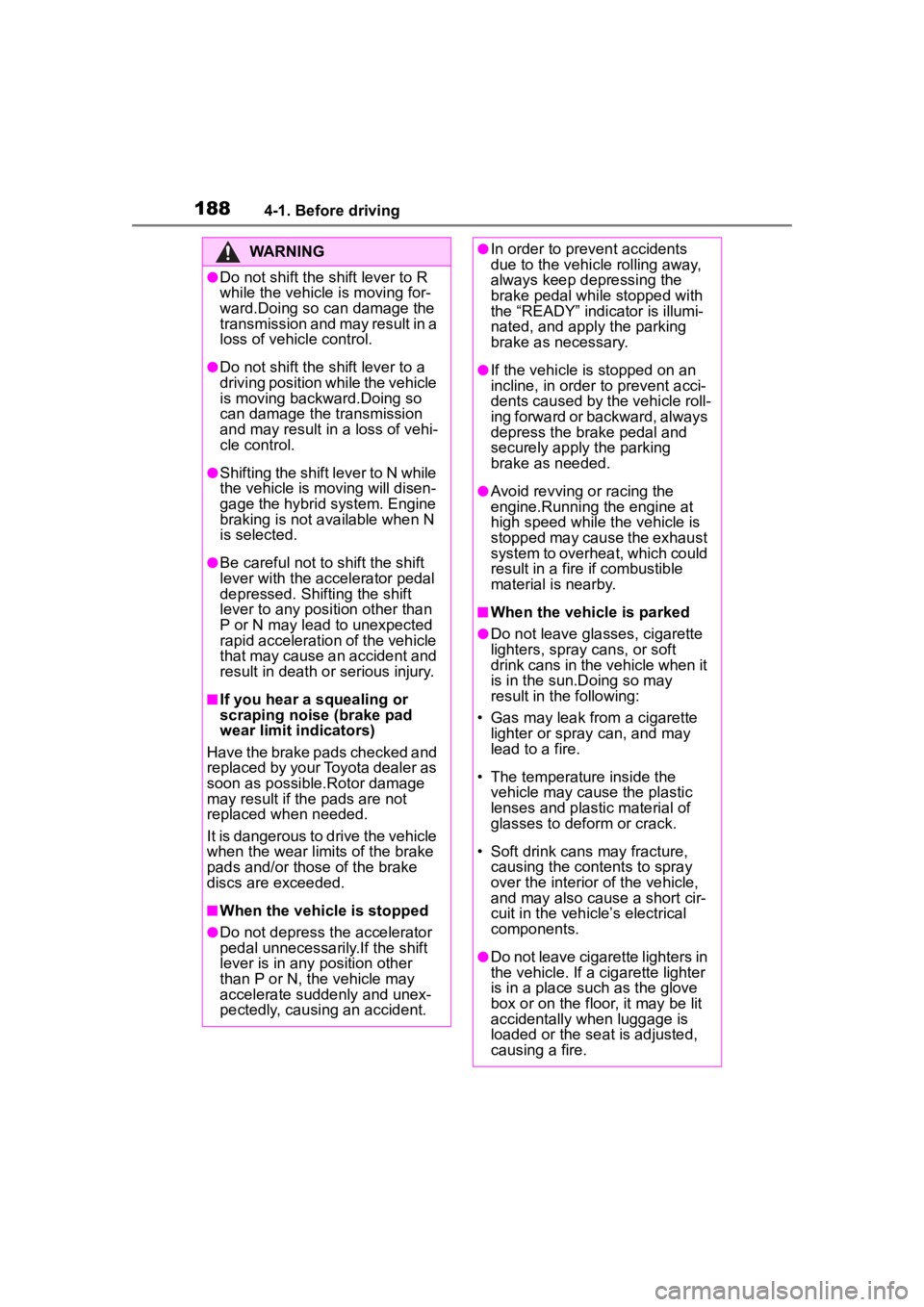
1884-1. Before driving
WARNING
●Do not shift the shift lever to R
while the vehicle is moving for-
ward.Doing so can damage the
transmission and may result in a
loss of vehicle control.
●Do not shift the shift lever to a
driving position while the vehicle
is moving backward.Doing so
can damage the transmission
and may result in a loss of vehi-
cle control.
●Shifting the shift lever to N while
the vehicle is moving will disen-
gage the hybrid system. Engine
braking is not available when N
is selected.
●Be careful not to shift the shift
lever with the accelerator pedal
depressed. Shifting the shift
lever to any position other than
P or N may lead to unexpected
rapid acceleration of the vehicle
that may cause an accident and
result in death or serious injury.
■If you hear a squealing or
scraping noise (brake pad
wear limit indicators)
Have the brake pads checked and
replaced by your Toyota dealer as
soon as possible.Rotor damage
may result if th e pads are not
replaced when needed.
It is dangerous to drive the vehicle
when the wear limits of the brake
pads and/or those of the brake
discs are exceeded.
■When the vehicle is stopped
●Do not depress t he accelerator
pedal unnecessarily.If the shift
lever is in any position other
than P or N, the vehicle may
accelerate suddenly and unex-
pectedly, causing an accident.
●In order to prevent accidents
due to the vehic le rolling away,
always keep depressing the
brake pedal while stopped with
the “READY” indicator is illumi-
nated, and apply the parking
brake as necessary.
●If the vehicle is stopped on an
incline, in order to prevent acci-
dents caused by the vehicle roll-
ing forward or backward, always
depress the brake pedal and
securely apply the parking
brake as needed.
●Avoid revving or racing the
engine.Running the engine at
high speed while the vehicle is
stopped may cause the exhaust
system to overheat, which could
result in a fire if combustible
material is nearby.
■When the vehicle is parked
●Do not leave glasses, cigarette
lighters, spray cans, or soft
drink cans in the vehicle when it
is in the sun.Doing so may
result in the following:
• Gas may leak from a cigarette lighter or spray can, and may
lead to a fire.
• The temperature inside the vehicle may cause the plastic
lenses and plastic material of
glasses to deform or crack.
• Soft drink cans may fracture, causing the contents to spray
over the interior of the vehicle,
and may also cause a short cir-
cuit in the vehicle’s electrical
components.
●Do not leave cigarette lighters in
the vehicle. If a cigarette lighter
is in a place such as the glove
box or on the floor, it may be lit
accidentally when luggage is
loaded or the se at is adjusted,
causing a fire.